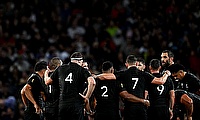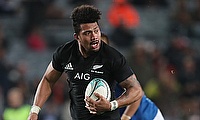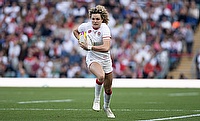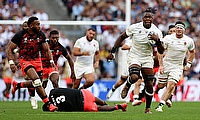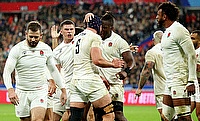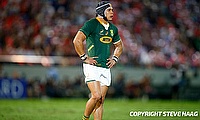England vs New Zealand - Who has the edge?
Dublin last weekend not only saw England’s hopes of a second consecutive Six Nations Grand Slam thwarted, it also saw their quest to beat New Zealand’s illustrious record of 19 consecutive test match victories fall short, a record that, until they next met the All Blacks in individual competition, might have presently enshrined England as the best team in international rugby.
England, as well all know, have been the form team in world rugby over the last eighteen months and despite the loss to Ireland at the Aviva Stadium, they remain second in the World Rugby global rankings behind only the aforementioned All Blacks. Indeed, England’s momentous 19-test run had led calls to see the game’s reigning world champions meet the European champions at Twickenham in November as a unique addition to England’s existing autumn schedule.
That fixture has since been postponed in favour of New Zealand facing the Barbarians in lieu of the English but with that mouth-watering clash arguably serving as the pinnacle of 2018 – a year without a Lions tour or a World Cup – it’s never too early to assess who would hold the edge when the world’s undisputed two best teams finally lock horns.
N.B. The two composite XVs are rough estimations of who the two sides would pick for the fixture based on previous selections and current standing within the international game.
Front Row: Mako Vunipola, Dylan Hartley and Dan Cole vs Joe Moody, Dane Coles and Owen Franks
One of the only areas where England would figure to have a clear advantage over the All Blacks is at the scrum and most precisely the front row.
Whilst Dane Coles is the superior hooker over Dylan Hartley (who may not even be the best English hooker available, see: Jamie George), the combined scrummaging power of Mako Vunipola and Dan Cole should be enough to turn Joe Moody and Owen Franks respectively.
Vunipola’s industrious and impactful carrying ability also gives England a further edge, even if Dane Coles’ foot speed could cause England issues.
Advantage: England
Maro Itoje & George Kruis vs. Sam Whitelock and Brodie Retallick
The most exhilarating matchup of the entire proposed fixture pits the two best second-row partnerships in the world against each other.
Itoje and Kruis pose a perfect duality between Itoje’s freak athleticism and Kruis’ strength although Retallick and Whitelock’s combined experience and handling give the All Blacks’ pairing a narrow advantage in the loose.
However, factoring in all four’s combined disruptive prowess the lineout, this one is too close to call.
Advantage: Neither
Chris Robshaw, James Haskell and Billy Vunipola vs. Jerome Kaino, Sam Cane and Kieran Read
Here the advantage shifts to the All Blacks.
Whilst Robshaw and Haskell are both proven international performers, neither can match the carrying or breakdown ability that Kaino and Cane both offer. Furthermore, although they have been Eddie Jones’ preferred flanker pairing thus far, neither Robshaw and Haskell possess the skillset to constitute a true openside flanker, whereas Kaino and Cane are perfectly suited to play off each other at 6 and 7.
Erstwhile the matchup at Number Eight consists of the classic ‘brains vs brawn’ approach (although both players have both in spades). Vunipola is arguably the best ball-carrier in world rugby bar none and his immense physicality could rip holes in the All Blacks for the entire eighty minutes. On the other side however, Reid is the consummate back-row player offering astute line-breaking ability as well as intricate linkup play, off-loading and volumes of leadership.
Regardless of who ultimately comes out on top between Vunipola and Read, Cane and Kaino swing this one for New Zealand.
Advantage: New Zealand
Ben Youngs vs. Aaron Smith
Two players whose form has swung back-and-forth over the last year, Youngs and Smith, despite their contrasting styles of play, offer foundational platforms for their respective teams.
Whilst Youngs’ all-round game doesn’t quite compare to Smith’s, it is the latter who has suffered from the more volatile run of form, having lost his All Blacks shirt to Tawera Kerr-Barlow in 2016. However, Youngs has also suffered from bouts of inconspicuousness in an international jersey and on his day could easily be out-classed by Smith’s potent sniping and decision-making.
Advantage: New Zealand
George Ford vs. Beauden Barrett
The reigning World Rugby Player of the Year and talisman of the reigning Super Rugby champions, the Hurricanes, Barrett is probably the best pure fly-half in the world as of this moment. Although George Ford performed admirably during England’s unbeaten run, his individual influence – as good as it is – pales in comparison to Barrett.
Owen Farrell and Jonathan Joseph vs. Anton Lienert-Brown and Malaki Fekitoa
Owen Farrell and Jonathan Joseph lit the Six Nations on fire as a tandem in 2017 with Farrell’s calm decision-making and passing ability allowing’s Joseph quick feet and foot speed to flourish against confounded defences.
Anton Linert-Brown and Malaki Fekitoa however offer a similar best-of-both dynamic with Linert-Brown a more elusive runner than Farrell and Fekitoa a more powerful carrier than Joseph.
However, Farrell’s tactical nous and kicking prowess in combination with Joseph’s mazy ability ball-in-hand give England the edge in the midfield.
Advantage: England
Jack Nowell and Anthony Watson vs. Waisake Naholo and Julian Savea
Whilst Jack Nowell and Anthony Watson – when both are fit and available – have proven to form a formidable partnership on England’s wings, the unique combination of power, pace and instinctiveness that both Julian Savea and Waisake Naholo possess give the All Blacks a notable advantage on the touchline.
England’s strength here comes from Watson’s aerial ability – the greatest of the quartet – and Nowell’s industriousness in sniffing out opportunities in-field, but it is impossible to overlook the physical attributes Savea and Naholo can utilise with ball-in-hand and in covering defence.
Advantage: New Zealand
Mike Brown vs. Ben Smith
Two players potentially entering the dusk of their international careers, neither Mike Brown nor Ben Smith can no longer solely rely on their (admittedly still formidable) physical gifts.
The battle at fullback therefore comes down to each player’s ability to make tactical decisions and provide a solid safety net behind the defensive line. Here the advantage lies with Smith, who not only offers a more reliable and powerful kicking game but whose instinctiveness and opportunism with ball-in-hand dwarfs that of Brown whose bulldozing style has been met with decreasing effectiveness on the international stage in the last few seasons.
Advantage: New Zealand
To summarise then, despite England’s formidable resurgence back into the top-two of world rugby, it would appear once all positions and players are accounted for, New Zealand – on paper at least – still retain a narrow advantage over the challengers for their global crown.

